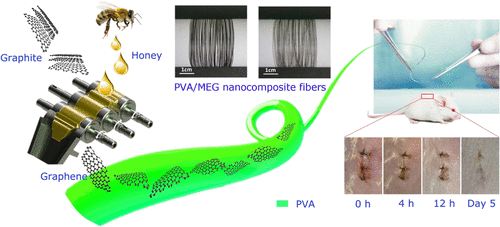当前位置:
X-MOL 学术
›
ACS Appl. Mater. Interfaces
›
论文详情
Our official English website, www.x-mol.net, welcomes your feedback! (Note: you will need to create a separate account there.)
Robust and Antibacterial Polymer/Mechanically Exfoliated Graphene Nanocomposite Fibers for Biomedical Applications
ACS Applied Materials & Interfaces ( IF 9.5 ) Pub Date : 2018-01-12 00:00:00 , DOI: 10.1021/acsami.7b17835 Yu Ma 1, 2 , Dongchen Bai 3 , Xinjun Hu 1 , Nan Ren 1 , Wensheng Gao 1 , Songbo Chen 1 , Huqiang Chen 1 , Yue Lu 1 , Jiangong Li 1 , Yongxiao Bai 1
ACS Applied Materials & Interfaces ( IF 9.5 ) Pub Date : 2018-01-12 00:00:00 , DOI: 10.1021/acsami.7b17835 Yu Ma 1, 2 , Dongchen Bai 3 , Xinjun Hu 1 , Nan Ren 1 , Wensheng Gao 1 , Songbo Chen 1 , Huqiang Chen 1 , Yue Lu 1 , Jiangong Li 1 , Yongxiao Bai 1
Affiliation

|
With the increasing demand for composites of multifunctional and integrated performance, graphene-based nanocomposites have been attracting increasing attention in biomedical applications because of their outstanding physicochemical properties and biocompatibility. High product yields and dispersion of graphene in the preparation process of graphene-based nanocomposites have long been a challenge. Further, the mechanical properties and biosafety of final nanocomposites are very important for real usage in biomedical applications. Here, we presented a novel high-throughput method of graphene on mechanical exfoliation in a natural honey medium, and a yield of ∼91% of graphene nanoflakes can be easily achieved with 97.76% of single-layer graphenes. The mechanically exfoliated graphene (MEG) can be well-dispersed in the poly(vinyl alcohol) (PVA) matrix. The PVA/MEG nanocomposite fibers are obtained by gel spinning and stretched 20 times. As a candidate for monofilament sutures, the PVA/MEG nanocomposite fibers with 0.3 wt % of MEG have an ultrahigh ultimate tensile strength of 2.1 GPa, which is far higher than that of the neat PVA fiber (0.75 GPa). In addition, the PVA/MEG nanocomposite fibers also have antibacterial property, low cytotoxicity, and other properties. On the basis of the above-mentioned properties, the effects of a common surgical suture and PVA/MEG nanocomposite fibers on wound healing are evaluated. As a result, the wounds treated with PVA/MEG nanocomposite fibers with 0.3 wt % of MEG show the best healing after 5 days of surgery. It is possible that this novel surgical suture will be available in the market relying on the gentle, inexpensive method of obtaining nonoxidized graphene and the simple process of obtaining nanocomposite fibers.
中文翻译:

生物医学应用中坚固耐用的聚合物/机械剥离石墨烯纳米复合纤维
随着对多功能和集成性能复合材料的需求不断增长,基于石墨烯的纳米复合材料因其出色的理化特性和生物相容性而在生物医学应用中引起了越来越多的关注。长期以来,在石墨烯基纳米复合材料的制备过程中,石墨烯的高产品收率和分散性一直是一个挑战。此外,最终纳米复合材料的机械性能和生物安全性对于生物医学应用中的实际使用非常重要。在这里,我们提出了一种在天然蜂蜜介质中机械剥落石墨烯的高通量新方法,使用97.76%的单层石墨烯可以轻松实现〜91%的石墨烯纳米薄片的产率。机械剥离的石墨烯(MEG)可以很好地分散在聚乙烯醇(PVA)基质中。通过凝胶纺丝并拉伸20倍获得PVA / MEG纳米复合纤维。作为单丝缝合线的候选材料,MEG含量为0.3 wt%的PVA / MEG纳米复合纤维具有2.1 GPa的超高极限拉伸强度,远高于纯PVA纤维(0.75 GPa)的极限拉伸强度。另外,PVA / MEG纳米复合纤维还具有抗菌性能,低细胞毒性和其他性能。基于上述性质,评估了普通外科缝合线和PVA / MEG纳米复合纤维对伤口愈合的影响。结果,用具有0.3wt%的MEG的PVA / MEG纳米复合纤维处理的伤口在手术5天后显示出最佳的愈合。
更新日期:2018-01-12
中文翻译:

生物医学应用中坚固耐用的聚合物/机械剥离石墨烯纳米复合纤维
随着对多功能和集成性能复合材料的需求不断增长,基于石墨烯的纳米复合材料因其出色的理化特性和生物相容性而在生物医学应用中引起了越来越多的关注。长期以来,在石墨烯基纳米复合材料的制备过程中,石墨烯的高产品收率和分散性一直是一个挑战。此外,最终纳米复合材料的机械性能和生物安全性对于生物医学应用中的实际使用非常重要。在这里,我们提出了一种在天然蜂蜜介质中机械剥落石墨烯的高通量新方法,使用97.76%的单层石墨烯可以轻松实现〜91%的石墨烯纳米薄片的产率。机械剥离的石墨烯(MEG)可以很好地分散在聚乙烯醇(PVA)基质中。通过凝胶纺丝并拉伸20倍获得PVA / MEG纳米复合纤维。作为单丝缝合线的候选材料,MEG含量为0.3 wt%的PVA / MEG纳米复合纤维具有2.1 GPa的超高极限拉伸强度,远高于纯PVA纤维(0.75 GPa)的极限拉伸强度。另外,PVA / MEG纳米复合纤维还具有抗菌性能,低细胞毒性和其他性能。基于上述性质,评估了普通外科缝合线和PVA / MEG纳米复合纤维对伤口愈合的影响。结果,用具有0.3wt%的MEG的PVA / MEG纳米复合纤维处理的伤口在手术5天后显示出最佳的愈合。



























 京公网安备 11010802027423号
京公网安备 11010802027423号